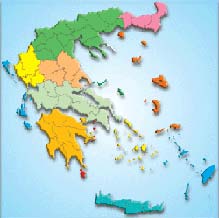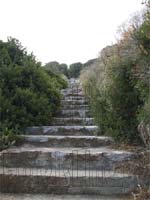
Please click on the map,
the region you want to visit |
|
|
|
|
| |
|
 |
Three Kouros in Naxos |
|
KOUROS IN FLERIO OF MELANA

The Naxian land is very rich in fine marble, which is currently the subject of intense exploitation. The marble is not only serving the needs of Naxos and of Greece, but it is exported to Europe and America. The same happened in antiquity. The Naxians began first the widespread use of this noble material in architecture and sculpture. The craftsmen, starting from the extensive quarries of surface area between Flerio of Melana and Potamia and working in Naxos island, in the Ionian city of Delos, in Athens, Boeotia and other more distant locations, pioneered during the 7th and the 6th century in the development of the Greek monumental marble architecture and sculpture.
To a large extent, on the hills of the region, rich relics of the ancient quarrying activity were preserved, which activity continued with less intensity and in the rest of antiquity. Quarrying traces observed on the rocks next to the unfinished statue.
The architectural fragments and the sculptures in the quarry acquired their shape and were transported to their destination without the finishing work (not to suffer damage during transport) for their final configuration.
The transportation on the slope was done by ropes and wooden sled on paved road (on small pieces of marble that were produced during its manufacture).
Accidents during the procedure could happen, especially when the works were too big and fragile. Then, the works could be abandoned at the quarry. Another reason for abandonment was the tardy discovery of flaws in the marble, the cancellation of an order or political events.
In the case of this statue is likely that the legs were broken during transportation. |
 |
 |
The statue is depicting a naked young man in a supernatural size and height of 5.5 m, in an archaic, inert attitude. It is dated around 570 BC. It is the time when powerful nobles of an aristocratic society ordered imposed monumental works that their majesty is based on the strict structure and size.
The stage of treatment of the sculpture is advanced, but is less than that of the other incomplete statue that remained on the mountain. The fine proportions, the flowing contours and the lack of sensation of the flesh, which characterize the work, are traits of the style of Naxos sculptures.
Kouros in Flerio named "Greek", because it obviously represented values such as "size" and "power" that are identified with Greeks. The Kouros is under the protection of Kondylis family, which owns the well-tended garden. |
|
|
|
 KOUROS IN POTAMIA (between Flery and Potamia) KOUROS IN POTAMIA (between Flery and Potamia)
On a steep and difficult trail that starts near the site where Kouros of Flerio is situated and after a trail of 300-400 m, you will discover the less known and visit able Kouros of Naxos. |
 KOUROS IN APOLLONAS KOUROS IN APOLLONAS
In the northern part of the island, just before the junction to the pretty fishing village of Apollo (if you follow the coastal road from Chora to Apollo or shortly after the junction if you come from Apeiranthos) is another ancient quarry.

At its entrance, it is lying on the ground, from which has never been moved, an unfinished statue of a Kouros, height 10.45 m, which dates to the early 6th BC century and probably is the personification of Dionysus.
On the hilltop of the quarry is the inscription "mountain area of temple of Apollo" dating from the 5th to 4th century BC and probably it belongs to a temple of a God which was there. |
 |
Accommodation and Entertainment proposals in Naxos |
|
|
|